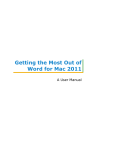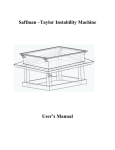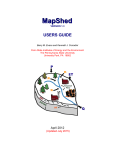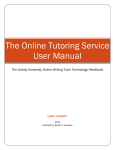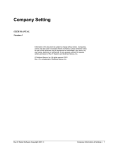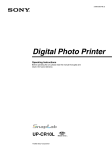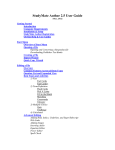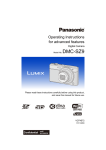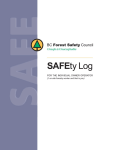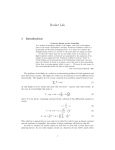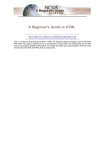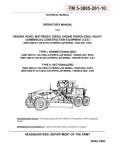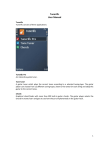Download A GUIDE TO THE PREPARATION OF THESES AND DISSERTATIONS
Transcript
A GUIDE TO THE PREPARATION OF THESES AND DISSERTATIONS IN SCIENCE AND ENGINEERING 1. INTRODUCTION As an M.S. or Ph.D. candidate you are now involved, or will be soon, in the exciting but exacting business of turning your research -- your testing and reading, your findings and conclusions -- into a clear, complete, well-written, and convincing thesis or dissertation.1 The task may seem formidable. It once seemed formidable to almost all of your professors. This guide is intended to help you write the best thesis you can by anticipating and answering common questions about content, structure, format, figures, and language. We have also included some suggestions on how to manage the process of writing. This guide is a short and selective reference for writing theses and is not intended to cover every detail. You will notice, for instance, that there are no sections on grammar or punctuation or theories of composition. This guide is not a substitute for owning and making frequent use of a good dictionary and a good composition handbook. We have included a short bibliography of a few of the more usable handbooks. To help you edit and polish your writing, at least one of these should live on your desk for the rest of your professional life. To write well, knowing your audience is critical. The first reader of a thesis is your supervising professor. Know your supervisor’s preferences about content and style before you begin; most professors have a well-developed (though unwritten) list of dos and don’ts. This guide contains our list, but your supervisor might have different opinions. Show your supervisor this guide, and ask where he or she agrees or disagrees. Besides your supervisor, the only other guaranteed readers are the other members of your committee, but a highly likely set of readers is a few subsequent graduate students, either in the same research group or those doing related work elsewhere. Some readers will be led to your thesis by your own published article--they want and expect more detail in the thesis. An excellent thesis might be read by a wider audience, and you want to ensure they can appreciate your contribution to knowledge. In the next three sections of this Guide, we address the major writing and organizational issues that are common to most scientific and engineering theses. Our ideas should make the task before you more manageable and start you on the path of writing. We call attention to problems that we have seen repeatedly in engineering graduate students' drafts in hopes that you will avoid them. These problems go beyond the mechanics of language and composition into the realm of weak argumentation and incomplete content: inadequate interpretation of results, weak and/or incorrect use of figures, and failure to justify the work sufficiently. These problems can and should be addressed before your advisor sees your draft. We have divided these issues into sections covering the process of writing, the structure of a thesis, and the use and explanation of figures and tables. Of course no one should be expected to write a good and complete chapter, or even a couple of pages, in one draft. Revision is a vital part of the process of writing; you will have to revise most sections several times. But by the time you submit a chapter to your advisor, you should already 1 Throughout this document, we use the word “thesis” to mean both “thesis” and “dissertation,” except in the rare instances where we believe there is a difference between the two relevant to this Guide. have revised it at least once on your own. Section 5 should help you edit your own work by answering some of the questions you will have about style, verb tenses, numbers, and lists. 2. THE PROCESS OF WRITING For many people, getting started on a writing project resembles a scene out of a Stephen King horror novel: the blank screen looms larger and larger while the poor graduate student drains cup after cup of coffee, sweat breaking out on her brow. The difficulty of beginning is real, but fortunately for engineering researchers, you never have to start with nothing: you already have your methodological approach (probably spelled out in your notebook) and some data with which to start. One key question students ask us is, when is the optimal time to start writing? And the answer is, whenever you have worked through with your advisor what will be your experimental or mathematical approach. Writing in fact can help your engineering work by indicating where there are remaining gaps in your approach. Writing a first draft of a chapter tells you what data or information you still need to collect and whether your methodology holds up. If you think of writing as a process with several steps, you will realize it is akin to any project management; you must define your objectives, plan your document or chapter (outline), draft, evaluate, and then revise. Since your thesis Introduction will contain your statement of research objectives, you should attempt a draft of that chapter early in your work, to see in what direction that work is going or needs to go. Next, you might attempt a draft of your Methods chapter or the Literature Review. You may or may not show these drafts to your advisor -- these early writing attempts are mostly for your benefit alone. Certainly you will want to create an outline as soon as you have worked out your methodological approach. You can use the chapter headings outlined in the following section and fill in the gaps as you proceed with your thesis work. Like those early drafts, a working outline is for your use and should evolve over time -- only when the last word is written will your final outline (which is your Table of Contents) be complete. Aside from outlining, you will want to organize in other ways before you start writing any particular section. Group your notes into related topics and keep those notes in front of you. For chapters with figures, prepare those figures first and group them in a logical sequence. As you write, connect together your figures and tables and groups of related topics. To write the Results chapter, you really need to know all your results first. As you revise your sections, focus first on the subsections, then on the paragraphs, and finally on the sentences and individual words. Does each subsection flow into and from the surrounding subsections? Does each paragraph contain one point or a few closely related points? Does each paragraph help build the story you are telling; does it put another brick on top of the foundation of the previous paragraph? At the sentence level: Is your grammar correct? Are your sentences too long or too choppy? Are you using extraneous words? Please see the bibliography at the end of this Guide for a short list of grammar and style handbooks to help you answer those pesky grammar questions on who/whom/, which/that, etc. Most importantly, remember that technical writing is an iterative, recursive process. You will write and rewrite (and rewrite again) each subsection, not because you are a “bad” writer but because you are a careful communicator and a committed researcher who wants to produce a readable contribution to knowledge in your field. 3. STRUCTURE OF A THESIS A typical thesis or dissertation has five major parts: • • • • • Introduction Literature Review Experimental Methods or Model Development Results Conclusions Theses also have back matter--References and Appendices--and an essential part up front--the Abstract. The Abstract is intended for separate publication in reference works such as Dissertation Abstracts; it must be written to stand alone. It is a brief (300 words), one-paragraph summary of the purpose and principal findings of your work. The abstract comes first (before the Table of Contents) but it should be written last. Some potential readers do not need the entire document to learn what they need; others will pick up your thesis unsure of whether they need or want to read the entire document. These readers are likely to read the Introduction and the Conclusions to determine if this thesis contains what they seek. Think of these two chapters as forming an executive summary; taken together, they summarize the entire research project and give detailed conclusions. The above outline is based on the assumption that the research is primarily either experimental or mathematical, but scientific and engineering research today often has a substantial component of both. In such cases, the structure of the thesis should match the research. If the research included the development of a mathematical model as well as experimental work, and the model yields insights on its own (without direct reference to the experimental work), the thesis might include separate chapters for the model development, model results, experimental methods, experimental results, and a comparison of the model predictions to the experimental results. In this case, two chapters in the above outline have mushroomed to five. In other situations, the two pillars of experimental and mathematical work might not be equal, at least as done by the writer. Using someone else’s model or experimental results, for example, might allow that other researcher’s work to be introduced (perhaps extensively) in the Literature Review and then used in a separate chapter on the comparison of model predictions and experimental results. In this case, only one additional chapter from the above outline is needed. In a more extreme example, the modelexperimental comparison might simply be a section of the Results chapter, maintaining the structure above. Develop an outline that fits your research contribution; chapters are a strong indicator to a reader of the level of importance. In any case, the concepts for writing such additional chapters are identical, so this Guide follows the simpler outline above. While chapters represent major divisions, they must also be linked. A common error in writing the central chapters (all but the first and last) is to omit these linkages; many students end each chapter abruptly, and start the next equally abruptly. At the end of each of these chapters, provide a brief summary of what has been said, and state how it feeds into the next chapter or the remaining chapters. Also, at the beginning of each chapter, give readers an overview of the chapter to let them know what to expect throughout that chapter and how it takes advantage of what has already been explained. Theses and dissertations are long and filled with details; your writing takes readers on a journey through all these details. Readers need not only road signs (chapter and section titles) but some maps that let them know their progress (or, really, your progress in fulfilling the objectives of the thesis). It only takes a few sentences at the end of one chapter and another few sentences at the start of the next for a reader to be re-oriented. 3.1 Introduction The Introduction is a brief (approximately three pages, occasionally as long as five) overview of the problem you have addressed and the approach you have used to solve or further understand this problem/phenomenon. The introduction is written for a wide audience; any college-educated person should be able to read and understand it. You can think of this chapter as a funnel with a stem. The first part narrows the reader's focus from all possible topics to the specific question your research addressed; it provides context to show how your work fits into a much broader arena. It also provides, in a broad and general way, the justification for your research, indicating that the answer to a certain question (your question) is not known from previous research and that the answer has value. The stem, or second part, is far more specific. It begins with a precise definition of the specific problem or question, and a precise set of objectives for the research. This statement of the problem and the objectives deserves its own section, and here “precise” refers to every single word. Ultimately, the success of a thesis will be judged on whether the objectives are met, so make it clear what that measure of success should be. Next, the reader wants to have an idea of how you went about answering the question you have now posed so well--provide a section that explains the approach in two to four paragraphs. This length gives you sufficient space to define for the readers what they can expect to find in detail later. Be positive, i.e., spend far more of your limited space saying what you did rather than what you did not do. Explaining limitations is fine and might be necessary to avoid misleading a reader, but do not dwell on limitations if you really want someone to read the thesis. You will have space later in the thesis to fully explain limitations. Finally, we believe it is useful to provide a brief guide to the rest of the document. Note how, in our introduction, we gave you a verbal outline of this document, giving more of a flavor of the content of each section than the table of contents does. Provide this kind of roadmap. 3.2 Literature Review The Literature Review serves three purposes: • to justify your work, i.e., to justify both that the question is worth addressing, and that the approach you have taken is reasonable and likely to provide insight • to prove to the knowledgeable reader (e.g., committee members) that you understand the context of your work • to introduce newcomers (e.g., subsequent graduate students) to the important research relevant to your subject The Literature Review surveys what other professionals have written or demonstrated about the problem you are addressing. You want to include all work that is relevant to your work, to demonstrate continuity from previous work to yours, and to show where your work fits into the historical flow of ideas and conclusions about your particular subject. A critical element is to point out what other people have not yet done, to show the gaps which perhaps your work will partly fill. Many thesis writers neglect to show these gaps, thereby failing to demonstrate a substantial justification for their own work. The Literature Review should give the reader the conceptual underpinnings of your work, providing the foundation upon which your work is built. Ideas, methods, and specific findings of others that are germane to your work need to be explained here. Subsequent chapters will be easier for you to write and easier for the reader to understand if these underpinnings are explained well. Some students are concerned that explaining what others have done might make their own contribution seem small and unworthy. Such thoughts are unhealthy--give credit where it is due. Better to err in claiming too little credit than in claiming too much. A reader’s appetite should be whetted by this chapter; he or she will want to know how you went about filling the gap that you have exposed. Students often wonder about the length of this chapter, or, in other words, the depth and breadth of coverage of the previous work. The answer will most certainly vary among different students and different supervising professors, and also will vary between theses and dissertations. The expectations for a doctoral student to understand the context and underpinnings of the research are greater than they are for a Master’s student, and therefore this chapter is likely to be longer in dissertations than in theses. Ask your supervising professor for guidelines. Clearly, those subjects that are only tangentially related to your question need only brief coverage, while those that are central require more complete exposition. The former might be handled by referring to an excellent overview article and writing only a sentence or two yourself, while the latter need your explanation in greater detail, even if someone else has written the perfect summary. Others’ summaries are unlikely to expose the gap you need to open in the reader’s mind, and they do nothing to prove your understanding. The reader should not be required to go elsewhere to learn important background to your work; on the other hand, the reader should be able to see clearly that anything you report in this chapter is related to your question and your approach. This chapter is not a place to show off that you can make more citations than anyone else; make citations that are relevant to the purposes of this chapter. Sectionalizing this chapter can present some challenges and, again, we cannot give a universal blueprint. Many theses draw several topics together, and the Literature Review might best be accomplished by explaining each topic individually in separate sections or subsections. Some sections might be best written by showing the development chronologically; others might use a conceptual theme as the organizational element. You might think of the chapter, or each section of the chapter, as similar to a television camera gradually zooming in on a subject; greater detail is exposed as the lens gets closer to the subject. 3.3 Experimental Approach and Methods/Model Development This chapter is usually the easiest to write because you are telling what you did, how, and (when necessary) why. Much of this section is written in the past tense because much of the time you will be describing specifically what you did in the past rather than explaining theories and general concepts. An Experimental Approach and Methods chapter should give an overview, as well as the details of your research approach. The research design should be delineated and explained--what sets of experiments were performed, and what was the purpose of those experiments? What conditions were chosen, and why? Which variables were held constant and which were varied, and why? The principle of the Methods chapter is this: give sufficient detail that someone else at a different institution could duplicate your work without calling you on the telephone or sending you an email. If a compilation of standard procedures exists in your field or if you followed someone else's methods, you may reference the methods without repeating them in full, but you should explain any deviations or special tricks you used. Do not explain techniques that you later found to be flawed, i.e., do not write an historical record. Include only those procedures used to obtain the results you actually report in the subsequent chapters. If you found someone else’s method to be flawed, say so and explain the flaw so that others will not fall into the same trap. If you had choices about how to measure some quantity, justify your choice. You need to describe your apparatus only if it is not standard or commercially available. Do note and emphasize any hazards in a separate paragraph introduced by the word "Caution." And do discuss your quality control measures: how accurate are your measured values? Calibration curves for experimental methods belong in this section. Often, a section is needed that explains the steps required to do an experiment; such sections usually come near the end of this chapter because to understand them completely the reader needs to know details of individual parts of those steps. Organize the chapter so that it is easy for readers who do not need the exquisite detail to know what to skip; liberal use of subheadings (but not sub-sub-subheadings) helps. For Mathematical Model Development, the choices and assumptions you made along the way must be justified; the conceptual content of this chapter is likely to be deeper in this case than in experimental methods chapters. However, the principle is the same: give sufficient detail that the reader understands the choices that were made in dealing with the fine points of model development. If your computer program used library subroutines, refer to them and state if any changes or special tricks were used to make them fit into your work. Questions of numerical instability belong in this chapter. A brief “User’s Manual” might be included to give the reader an understanding of the steps required to utilize the model. Sample outputs or dialog screens should be included. And, as for experimental reporting, organize the chapter so readers who do not need every detail know what to skip at a glance. 3.4 Results This extremely important section details not only what happened but what is your interpretation of what happened. Your results and your discussion of those results should be mixed together with increasing amounts of interpretation ladled out to the reader as the chapter progresses. This chapter is tricky to write because you must put the results and the interpretations in some order that makes sense and that will gradually develop the full understanding of the reader. It may help to think of this chapter as a story you are unfolding, weaving in figures and tables as appropriate. If your results have more than one possible interpretation, state all interpretations and give your judgment about which one is right. These judgments are what differentiate a good thesis from a poor one. These judgments are also what you as an engineer or scientist are paid to make. So, make your interpretive judgments and justify them. Be sure to interpret every figure. If a figure is worth showing, it is worth commenting upon. Do not just repeat in words what the figure demonstrates visually; go further and state the relevance of that demonstration to your work and your conclusions. You should "milk" your data for every bit of relevance; we find it far more common for students to under-interpret than over-interpret their data. If your interpretation crosses the line into conjecture, label it that way. Your supervisor and committee will pull you back if you have gone too far. The layout of the Results chapter can take different forms, but here are some suggestions. Do not tell the history of what you did; chronology is probably not the operational conceptual framework for your discussion. Also, every data point is not equally important, so do not think that every data point need be shown. Rather, choose what you need to say to justify the conclusions and expose your own thought processes in getting to those conclusions. If you investigated how several different independent variables influence the process or phenomenon you are studying, make a separate subsection for each and proceed in an order that is logical and easiest for the reader to follow. Interpret your results as they are presented; do not wait until several results have been exposed before telling the reader what they mean. Sometimes, two trains of thought (and corresponding experiments or model runs) have to be developed separately to a certain point before their interaction can be considered. Build complexity gradually. If you did a series of experiments (or computer model runs) that were similar, perhaps you can show detailed results of one typical experiment first, illustrating all the (fruitful) ways in which you analyzed the data from that one and explaining the lessons to be learned from that one. Then, when you go on to show other results, you do not need to show as much data or detail—you can show the differences between subsequent experiments or model runs (subsequent in your chapter, not necessarily in your work) and the typical one already shown. These comparisons between different experiments (conditions) are likely to be done on the basis of parameters derived from the raw data rather than the raw data alone; all you need to do is to explain once how you go from the raw data to the parameterized result. Raw data are likely to be useful to some future reader (including yourself or your advisor at a later date), so collect them in an appendix. After all the results have been presented, explained, and interpreted step by step, it is quite valuable to give a more global interpretation. You can discuss how your results compare with others, how they fill the gap that you exposed in the Literature Review chapter, the extent to which they leave some questions unanswered, and the implications for or applications to real world engineering. 3.5 Conclusions Recall that the Conclusions chapter along with the Introduction should form an excellent summary for many readers. And for readers who have journeyed through your entire thesis, chances are they need a refresher on the overall objectives and design of your work. The first part of the Conclusions chapter, therefore, must contain a very brief synopsis of the research approach and design--an abbreviated statement of objectives and an overview of how these objectives were met. The summary of the approach must be short (approximately one page or less) so as not to bore the person who has read it all, but still contain more detail than in the Introduction. Put the conclusions themselves in a separate section, and remember the following points: • Be brief, as brief as possible • Enumerate your main findings in point form: 1, 2, 3, 4 • Be crystal clear and very concise • Add absolutely no new information After the conclusions, include one or both of two additional sections, one on the implications or significance of the research, and the other on suggestions for future research on the topic (or another related question that has been developed through this research). Brevity is preferred. In total, this chapter should be in the range of three to six pages; remember that you are adding nothing new for the reader who has read the entire document, and the quick reader wants to be just that. 3.6 Sequencing the Writing Task Here is a sequence of writing drafts that many researchers find useful: • • • • • • • • • • Write draft of Introduction Write draft of Methods Write draft of Literature Review Write draft of Results Write draft of Conclusions Revise Introduction Revise middle three chapters Revise Conclusions Revise Introduction Write Abstract At this point, you should have a good second draft that may require only sentence-level editing. Notice that the Introduction is often rewritten twice. Write (or rewrite) the Abstract last. 4. FIGURES AND TABLES Figures and tables are the heart of any engineering or technical thesis. They display the data, and the exact relationship between data, that will give life and meaning to all interpretation and conclusions. If your figures are not clear and correct, your methodology begins to seem questionable to the reader, and the foundation for your interpretive judgments crumbles. The most important point to remember when integrating your text and your figures is this: Each figure should be explained and interpreted in your text and yet each should be able to stand by itself, to make sense even out of context. Explanation of your figure should answer two questions sequentially: 1. What information does the figure contain and how were those results obtained? 2. What does this information mean? First orient the reader to the particulars shown on the figure (experimental details, values obtained, etc.); then fully interpret and discuss all changes, relationships, processes, or phenomena indicated by these data. If your figure is partially a repetition of information shown on earlier figures, simply remind the reader of that information; do not repeat all of it. If the previous writing up to the point of any particular figure is good, very little new information should be necessary to answer the first question. You should focus instead on the meaning or interpretation of the information on the figure. Here are some instructions for constructing a clear, readable graph. The abscissa is the horizontal axis displaying values for the independent variable. The ordinate is the vertical axis displaying, usually, the values for the dependent variable. The point of origin of both the ordinate and the abscissa (with very rare exceptions) should be zero. Both axes should be labeled well. These labels should use words rather than symbols whenever possible and include the units of measurement; including both words and symbols can tie the figure well to the text. Generally, use units that are as independent of your experimental conditions and apparatus as possible. For example, a titration curve that shows the pH vs. the Volume of Acid Added (with units of milliliters) requires the reader to know (and the writer to supply) the strength of acid and the volume of sample. Expressing the abscissa as the Acid Added in units of milliequivalents per liter of solution is far better, because it avoids the necessity of such details and communicates the desired information about the sample directly. Some further guidelines for designing technical illustrations are as follows: • Position each illustration as near as possible to the narrative it supports, but after the first reference to it. • Label each figure or table clearly with a number and a title. For tables, the number and title are centered above the table. For figures, the number and title go beneath the figure. Your graphics program might have different defaults, but override them. • Give experimental details either on the figure itself or in parentheses after the title. • Create a title that draws attention to significant aspects of the illustration. Be more creative than to use a "y vs. x" title. • Make your figures right the first time, including the labeling and titling; it takes the same amount of time whenever you do it, and it is easier to write the text when you have final figures. • Use lines for model predictions and points for experimental data, especially when comparing one to the other. • Follow the convention for direction (when charts or figures are printed sideways on a piece of paper, the paper should be turned clockwise to be read). • Keep every illustration as simple and uncluttered as the complexity of your data allows. In interpreting technical tables and illustrations, here are some common errors to avoid: • Repeating a good fraction of the data (especially from tables) in the text, thereby allowing the reader not to study the figure or table • Continually saying, "The figure shows . . ." The emphasis should be on the information, not on the word “figure.” • Not interpreting • Using "data" as a singular word 4.1 Series of Figures All of the above discussion is primarily directed toward the construction of simple, individual figures and tables. However, figures are not isolated from one another but form a part of an unfolding story and therefore are related to one another. Making those relationships easy for a reader to follow is part of your duty as the writer. Begin by making sure that related tables and figures are consistent with one another in style, titling, choice of symbols, and labeling. The same symbol should be used for the same independent variable or condition throughout a thesis; you might have to use the same symbol in different parts of the thesis for different things, but never use different symbols for the same thing. Make the choice of symbols as intuitive or easy to remember as possible; for example, use open and filled symbols of the same shape to indicate values before and after a process (or other direct relationships), while different shapes are used for different conditions. In a recent thesis on water filtration comparing the results with spherical glass beads and sand media (which is angular), circles were used to indicate the spherical beads and triangles symbolized the sand. Follow your convention throughout the document. In short, do not make the reader study the legend on every figure as if it were a single, isolated figure. Similarities among figures run deeper than the choice of symbols; use a consistent style of presentation to show the same type of results, and choose titles that show both the similarities and differences in a series of figures. Often the same idea might be seen in more than one type of figure, but don’t be tempted to show off by using one type in one place and another in a second; consistency is a virtue. You could consider showing both types of figures the first time (especially if one might be simpler the first time but the other is ultimately more insightful), and tell the reader that throughout the remainder of the document, you have chosen to use one of these types. For titling, note how the following three titles from a thesis call attention to both the similarity and differences between figures: • Figure 4.14 Removal in Depths Normalized for Different Media Sizes: A Comparison of Experiments Conducted at High Filtration Velocities • Figure 4.17 Removal in Depths Normalized for Different Media Sizes: A Comparison of Experiments Conducted at Low Filtration Velocities • Figure 4.22 Removal in Depths Normalized for Different Filtration Velocities Even without seeing the figures themselves, you know that these three figures are visually very similar and come from closely related experiments. The titles help the reader focus not only on what to look for in each figure separately but also on what to think about when comparing the results in any two of these three figures. Consider using the same scale among different figures, even if it means that most of the data take up only half of the horizontal or vertical dimension on one figure; this choice makes it visually obvious that the results are quite different than those shown on another figure. One example (but not the only) would be in cases where the independent variable has intrinsic limits (e.g., zero to one); even if all the data for one graph are only spread over 30% of that scale, the visual effect of using the entire scale and having all the data in 30% of it is the easiest and most powerful way to show your reader what they need to know. And, if a subsequent, related graph uses a different fraction of the overall scale, the reader can immediately recognize the difference. Note in Figure 1 (whose primary purpose is explained subsequently) that all four parts have the same ordinate values, and it is immediately obvious that the parts on the right had far less variation and much higher values of removal efficiency than those on the left. Even if these figures were separated on different pages, these differences would be obvious to a reader. Incorporating these fine points of graphics and tables is one way to elevate your thesis from acceptable to outstanding. Your readers (including your committee) might never realize why they found your thesis so easy to follow. The overall idea is to be kind to your readers: do not confuse them or make them struggle to understand because of poor or inconsistent choices of axes, symbols, scales, titles, or labeling. 4.2 Complex Figures Often, the complexity of and relationships among your data cannot adequately be expressed with a single, simple x-y graph. A particularly powerful technique is to use two or more parts to a figure or table rather than to separate these into separate figures or tables. Most questions we ask in scientific or engineering research are multi-faceted, and understanding and explaining the multi-dimensional relationships are important—perhaps the entire goal of the work. A simple x-y graph is intrinsically two-dimensional; using multi-part graphs creates multidimensional space, and allows direct illustration of the complexity. In some cases, you investigate how a single primary dependent variable is influenced by several independent variables. If you show two (or more) separate sets of data on an x-y graph where each represents a constant value of another independent variable besides that shown on the abscissa, you have added a third dimension to that plot. If you now show an identical plot (same abscissa, ordinate, and third variable) but with yet another variable different than in the first graph, you have created a fourth dimension. For example, in the water filtration research mentioned above, particle size distributions were measured at different times and different depths (including the influent above the filter) in each experiment, and different experiments were performed under different conditions of media size and filtration velocity. A single graph might show, for example, the removal efficiency for a particular size class (the ordinate, calculated from results of the influent and at a certain depth) as a function of time (the abscissa) for two different media sizes (two sets of points using different symbols). Making that entire graph be Part A and putting Part B below it with results for a different size class allows the reader to see the effects of time, media size, and particle size in one figure. Adding two more parts to the right for similar results at a different depth illustrates the effect of that variable while keeping sight of the other effects. Figure 1 is an example of this presentation strategy. Two-part graphs are far more common, but this more complex example illustrates effects on the removal efficiency (ordinate) by time (every set on all four parts), media size (comparing the two sets on each part), particle size (comparing vertical parts of the figure), and depth (comparing horizontal parts of the figure). Simpler ways of illustrating some of these effects individually might also need to be shown, but this graph allows the reader to understand the complexity and interactions that might not be captured in any other way. In either case, it is far easier for the reader to understand and for you to explain this multidimensional space when it is all captured on a single figure (albeit with two or more parts) than if it is spread out in separate figures, probably on separate pages. Some of the individual relationships might need additional figures to draw out the details and gain specificity, but the interrelationships are often easier to explain when introduced by the multi-dimensional graph. These techniques should be used far more often than they are. Tufte’s books (see bibliography) explain many details of such figures, but your own creative thinking should be used as well. Students often want to know how many figures or tables should be in the Results chapter. There is no simple answer, but the guideline is to use as many (and only that many) as are needed to explain the results fully. Certainly more detail can and should be in the thesis than in a related journal article, and that detail requires or allows more figures and tables. But a common error is for students to put in too many figures in a first draft. Also, don’t repeat the data in both a figure and a table; choose which way helps the reader understand the point you are trying to make, remembering that you can include details in an appendix to ensure that the information is not lost for posterity. If you find yourself wanting to refer to five figures at once and only writing one paragraph about all five, you probably only need one or two of those five, and it is likely they can be best presented as a multi-part graph. Although you worked hard for every data point, your task is to make the reader understand your data without all that work. Don’t drag your reader through every data point. 5. COMMON QUESTIONS In this section we address some of the most common questions regarding sectionalization of the thesis, style and grammar, proper “voice” and verb tenses, and formatting lists and representing numbers. We do not, of course, cover every question we’ve ever heard; our choice represents those issues that arise repeatedly as students are preparing their documents. The first step in addressing issues of format should be to check the University of Texas guidelines on the preparation of theses or dissertations. These are available on the web at http://www.utexas.edu/ogs/pdn/ (Most universities have such a set of guidelines.) The guidelines discuss arrangement of pages and spacing--they specify double or space-and-a-half with paragraph indentation, for instance--but they say nothing about how to divide up and format chapters or sections. Given the variety of types of theses, from musical scores to software programs, the limitation of those guidelines is natural. The following suggestions on sectionalization reflect the common practice in technical fields. 5.1 Section Numbering Each chapter of a thesis is commonly broken into several separate sections and subsections. This sectionalization provides a valuable structure for you as you write and for the reader in understanding the research. Divide each chapter into sections and subsections; number each one and provide a meaningful heading for each. The numbering style is illustrated in this document; each decimal reflects a new sub-level. Do not use more than a three-point system (e.g., 3.1.2); a reader cannot keep track of what all the numbers mean if you use more. If you find yourself wanting to use more, the number of second-level (or second-digit) sections probably needs to be expanded. Perhaps in a long and complex thesis, you might find you need to use a four-point breakdown once or twice, but this exception should be invoked rarely. Formatting of the sections reflects the relative status of the different levels. Chapter titles are centered and capitalized; the chapter number can be written out (e.g., CHAPTER THREE) in a separate line above the title (also centered) or put as a digit before the title. The section and subsection numbers and titles are left-justified. Although a combination of capitalization, bolding, italicizing, and underlining to differentiate the levels can be used if desired, sections and sub-sections can have the same formatting since the numbering is the primary means of differentiation for the reader. In your first draft, take care of section numbering and titling. These details are inconvenient to format at any time. Straighten them out on the first draft and save your reader a lot of time and effort. With word processing programs you can easily make changes later. 5.2 Style The best way to get a feel for the appropriate style for academic writing is to read through a few recommended theses. Also, pay attention to the style of some of the journal articles and papers you are using in your research. The best of them will probably be easier to understand than some of the more ponderous but perhaps less fruitful studies. Many scientists and engineers write in a more ornate and old-fashioned style than is necessary today. Shorter sentences can often convey concepts quite as sophisticated as the ones all tangled up in very long and arcane sentences. Complexity of material does not have to result in density of style or in the inclusion of words that add nothing substantial to your meaning. When you revise your writing, look for unnecessary words and phrases, as in the following example: The following report outlines the different aspects relating to the current feasibility of constructing a magnetically levitated bullet train in Central Texas. The bolded words are all candidates for excision. On the other hand, your guiding light must always be the needs of your reader, who may need more explanation or context than you originally thought. You have to lead the reader through the forest of your own prose. And that reader needs signposts that answer basic questions: Which way is this thought going? How is this new sentence or clause related to the previous one? Good technical writing expresses such relationships clearly and establishes connection between pieces of information. Anyone can spew out data; your job is to create the conceptual framework, sentence by sentence, in which those data come to have significance. Several different “signposts” can clarify your writing for a reader. Transitional words and phrases act as signposts; without them, meaning sometimes becomes cloudy and ambiguous. Take this example: The project manager will leave for the convention on Friday. The project engineers will remain in the office. Is there a relationship between those two sentences? If so, what is it? Cause and effect? Simple chronology? Contrast? Without a transitional word or phrase at the beginning of the second sentence, we cannot know what the writer really intended. Another useful signpost is simple repetition of a keyword or unifying phrase. Notice this strategy in the following paragraph: Several devices are available to work with in meeting specified requirements. One such device is the aneroid control, used to limit the fuel while the turbocharger is building up manifold pressure during acceleration. Another device is the pressure-reducing valve, which reduces the pressure of the fuel entering the carburetor. We have also developed other devices that may be useful in the future. That paragraph also makes use of transitions--one, another, also--that establish multiplicity and addition, two concepts that the writers apparently would like to emphasize. As you read the following paragraph from a thesis introduction, notice how concepts are isolated from each other instead of being placed in relationship: Numerical results show that fluid loss can be divided into two parts: spurt loss and dynamic loss. Spurt loss is controlled by the formation permeability, fracturing fluids, injection conditions, and filter cakes’ properties. The slope of the spurt loss curve is mainly determined by the formation permeability. High permeability formation has a large slope. Dynamic fluid loss is controlled by the properties of the fracturing fluid and the filter cakes and by the minimum invaded-zone porosity. That paragraph can be improved by adding transitions, repeating key words, setting up lists more clearly, and by tying new concepts to previously stated concepts. Consider this revision: Numerical results show that fluid loss can be divided into two types: spurt loss and dynamic loss. The first type, spurt loss, is controlled by the presence of several factors: the formation permeability, fracturing fluids used, injection conditions, and filter cakes’ properties. Because the slope of the spurt loss curve is mainly determined by formation permeability, a high permeability formation has a large slope. The second type of fluid loss, dynamic loss, is controlled not only by the properties of the fracturing fluid and the filter cakes but also by the minimum invaded-zone porosity. Effective revision sometimes involves adding words and phrases, as in the paragraph above. At other times writing is best improved by combining short sentences. Shorter sentences are easier to handle and punctuate, but they are not always easier to read in sequence. Notice how flow is improved when these two sentences are combined: Original: The population explosion in and around Austin has proved to be problematic for water-retaining structures. It has particularly affected the Brushy Creek area in southern Williamson County. Revision: The population explosion in and around Austin has proved to be problematic for water-retaining structures, particularly those in the Brushy Creek area in southern Williamson County. The revised version above solves another common writing problem: using the indefinite pronouns, “it” and “this,” without a clear antecedent. This problem is especially widespread, and annoying, at the beginning of a sentence. Of course concerns about flow should never interfere with this important dictum: choose each word for its precision and appropriateness, never for its impressiveness. Often when we write we transport ourselves mentally into some artificial zone where words bear less relationship to reality as we know it. Some writers, even at the dawn of a new millennium, still write like this: "The investigators deemed it necessary to repeat the experiment because . . ." The word “deem" has a disconcertingly old-fashioned ring to it; why not write instead: "The investigators decided to repeat the experiment because . . ."? And please remember that "utilize" has exactly the same meaning as "use." Here is one practical strategy to use when you feel really stuck over how to explain something clearly on paper: imagine yourself explaining the concept or phenomenon to a friend with a similar education. You will probably "say it" more straightforwardly than you will write it. And your reader/listener will spend much less time getting the point. For more suggestions on how to control your style and how to revise effectively, see the suggested books in the attached bibliography. Strunk and White is especially easy to use and manages to explain quickly and painlessly almost all punctuation issues and such perennially confusing grammatical questions such as when to use “which” and when to use “that.” The following two subsections address two often confusing stylistic issues: which verb tense to use when, and which voice--passive or active--to use when. 5.2.1 Verb Tenses You always use the present tense when writing about theory or established knowledge: "The theory of relativity states that . . . ." You also use present tense, not past tense, to describe what your report or thesis does: Correct: Incorrect: This paper presents a new theory of evolution. This paper will present a new theory of evolution. Correct: Incorrect: This concept is explained in Section 2.4 This concept will be explained in Section 2.4. In any case, try not to refer ahead to a specific section or figure--this habit creates confusion for the reader, wondering if he or she should skip ahead to look at that reference. Use past tense, however, to describe what you did in your experimentation or data collection. And if you are speaking biographically of an investigator's actions, use the past tense: "In 1905 Einstein published his first theory of relativity." These general rules have implications for each chapter of your thesis. Your Introduction will be written in both past and present tense: present when you are showing how your work fits into established theory and practice, and past when you are giving specific background on what you did. Similarly, the Literature Review will be written in both tenses. Use past when stating what a researcher did: "The first major work on flocculation in turbulence was done by Saffman and Turner (1956)." Use present tense when describing generally accepted practices, concepts, and phenomena: "Turbulent flows have irregular fluctuations of velocity in all three directions." Use the past tenses to set up a historical continuum in which sequence is important: "By the time Data General was ten years old, its business had grown spectacularly" (past tense and past perfect tense). Your Experimental Methods chapter will be mostly in the past tense, since it states specifically what you did to achieve your results; the Results chapter will be a mixture of the two, like the Introduction. Your Conclusions will probably be cast mostly in the present tense, since your results are a contribution to established knowledge. And the Abstract's verbs will be mostly past tense, giving an overview of what you studied. 5.2.2 Passive Voice Passive voice refers to the way the verbs in a sentence are constructed. Passive voice is the opposite of the way we normally speak. We speak in active voice: "I threw the ball." Passive voice constructions put the object or the process or the phenomenon before the doer of the action: "The ball was thrown by me." In speech and in business writing we are usually interested in hearing about who did what. In technical writing, on the other hand, we are often more interested in the process or object. Thus, we want to read, "The material was heated to a temperature of 100 °C," not "The technician heated the material." Active voice constructions are generally shorter and sometimes clearer, but they are not always more appropriate. Your decision about which verb construction to use depends on two factors: what you want to emphasize in any given sentence, and what is the clearest way to convey the information. 5.3 Numbers How to represent numbers is a confusing concern for many scientific and technical writers. Here are guidelines for a consistent and correct representation of numbers and numerical values in the text of your thesis. General Rules • Write out the numbers "one" through "ten"; use arabic numerals for all the rest. • Do not, however, mix numerals and words for items in the same list: wrong: 15 wells, three aquifers right: 15 wells, 3 aquifers • Do mix numerals and words when the quantities are adjacent: wrong: 11 90-ohm resistors right: eleven 90-ohm resistors wrong: three five-person teams right: three 5-person teams Specific Rules • Use numerals for: units of measure (4 inches) time (3 pm, 8-second delay) page numbers percentages (7%) money ($6, 3 drachma) ratios (3 to 1 odds) • Use words for: A number at the beginning of a sentence wrong: 200 investigators worked on the experiment. right: Two hundred investigators worked on the experiment. Approximations wrong: 1/3 of the energy requirement right: a third of the energy requirement • Put parentheses around uncertainties when the equation is part of the text. example: L1 = 1.0 (± .071)cm 5.4 Lists How to format lists within a text is one of the most perplexing issues in writing and editing today. Very few composition handbooks and style manuals have anything to say about formatting lists, whether within a sentence or placed in vertical order. The few reference texts that do offer guidelines confine themselves to suggesting a numbering or lettering system and ignore questions on how to punctuate and introduce lists, especially vertical lists. Consequently, there simply is no set format in industry or academia. The following guidelines were prepared on the basis of two inquiries: • what system makes the most sense in contemporary technical writing? • what recommendations are found in the professional journal of The Society for Technical Communication? 5.4.1 Lists Within a Sentence Include your list within the sentence whenever the list is short (three or fewer items) or whenever each item is short. wrong: The elements in the test included: 1. zinc 2. lead 3. tin right: The elements in the test included zinc, lead, and tin. Lists are often preceded by a colon. Do not use a colon between a verb or a preposition and its object. wrong: The criteria were: cost, quality, reputation, and service. right: We used the following criteria: cost, quality, reputation, and service. If a complete sentence follows the colon, you have the option of capitalizing the first word after the colon. Elements within a list can be specifically enumerated to prevent misreading, to clarify a complex or lengthy series, or to highlight the listed items. Enumerations within a sentence should be introduced only by arabic numbers or lowercase letters, not by capital letters or roman numerals. Both Kate Turabian's A Manual for Writers of Term Papers, Theses, and Dissertations and The Chicago Manual of Style suggest that numbers or letters in a list stand out better when they are surrounded by parentheses rather than followed by periods. Use double parentheses rather than a single parenthesis or a period. wrong: The report consisted of four sections: A. introduction, B. discussion, C. results, and D. conclusion. wrong: 1) introduction, 2) discussion, . . . right: The report consisted of four sections: (1) introduction, (2) discussion, (3) results, and (4) conclusion. 5.4.2 Vertical Lists Lists that contain four or more items in a series may be prepared vertically, set off from the sentence that introduces the list. Vertical lists are usually introduced by a colon; however, if the list is preceded by a complete sentence, a period may follow the sentence. For the sake of consistency throughout a text it is a good idea to use a colon to introduce all vertical lists. Dashes or other punctuation marks should never introduce vertical lists. To enumerate vertical lists, follow the consensus of style manuals and use arabic numbers or lowercase letters followed by periods rather than surrounded by double parentheses. Punctuating vertical lists is often a major source of contention among editors and writers. If the listed items are complete sentences, periods may follow each separate entry in the list. Otherwise, do not include any punctuation marks in the vertical list. Here is an example of the suggested format: The hydroponic flooding system included the following components: 1. a sealed reservoir 2. an aquarium vibrator air pump 3. an automatic household timer 4. a plant container In this example, lowercase letters could be used in place of arabic numerals and each entry could begin with a capital letter instead of a lowercase letter. Note to Readers/Users This Guide stems from our experience in writing, teaching technical writing (H.H.), and overseeing the writing of theses and dissertations by several students (D.F.L.). The ideas expressed in this Guide reflect, in many cases, our personal prejudices about how theses should be composed; others might have differing opinions on certain aspects. We have reasons for our choices but have refrained from justifying them in this treatise for the sake of brevity. We welcome comments and suggestions (to [email protected] and/or [email protected]) for improving this Guide. 6. BIBLIOGRAPHY This bibliography is formatted according to ASCE requirements outlined in the publication noted below. Choose a referencing style that is used in a respected journal in your own field. Scientific and Technical Writing Elbow, P. (1981). Writing with Power: Techniques for Mastering the Writing Process. Oxford University Press, Oxford, England. Huckin, T, and Olsen, L. (1991). Technical Writing and Professional Communication for Nonnative Speakers of English, 2nd. ed. McGraw-Hill, New York, NY. Michaelson, H. H. (1990). How to Write and Publish Engineering Papers and Reports, 3rd ed. Oryx Press, Phoenix, AZ. Tufte, E. R. (1983). The Visual Display of Quantitative Information. Graphics Press, Cheshire, CT. Tufte, E. R. (1990). Envisioning Information. Graphics Press, Cheshire, CT. Valiela, I. (2001). Doing Science: Design, Analysis, and Communication of Scientific Research. Oxford University Press (chapters 5-11). Grammar, Style, and Diction American Society of Civil Engineers (2004). ASCE Authors’ Guide to Journals, Books, and Reference Publications. http://www.pubs.asce.org/authors/index.html The Chicago Manual of Style, 15th ed. (2003). University of Chicago Press, Chicago, IL. Harris, M. (2003). Prentice Hall Reference Guide to Grammar and Usage, 5th ed., Prentice Hall, New Jersey. Strunk, W. and White, E.B. (1972). The Elements of Style, 2nd ed. Macmillan, New York, NY. Turabian, K.L. (1987). A Manual for Writers of Term Papers, Theses, and Dissertations, 5th ed. University of Chicago Press, Chicago, IL.






















